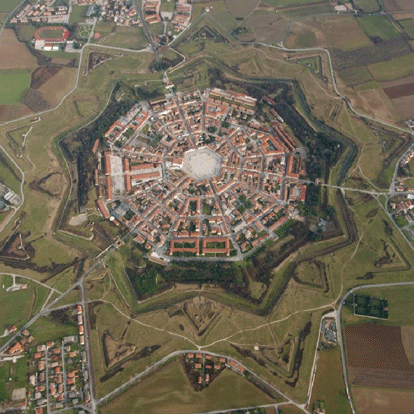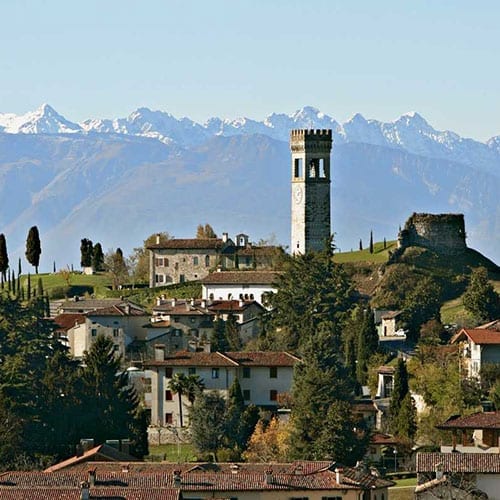 Valvasone Arzene
Valvasone Arzene
MUNICIPALITY OF VALVASONE ARZENE
(Pordenone Ditrict)
Altitude
mt. 59 a.s.l.
POPULATION
2195 (350 in the borgo)
TOURIST INFORMATION
Tourist office, Via Erasmo 1 – Ph. 0434 898898
valvasone@com-valvasone.regione.fvg.it
www.comunevalvasonearzene.it

The name Valvasone derives from the Old German words wal (which means ‘hill’ or ‘mound’) and waso (which means ‘meadow’), meaning ‘meadow with hills’.
History, art and timeless beauty. Valvasone Arzene is, quite rightly, considered to be one of the most beautiful villages in Italy, and it is located in the heart of Friuli Venezia Giulia. Visitors are enchanted by the town’s medieval and Renaissance architecture, quiet and cheerful squares, streets and alleys, and views that preserve centuries of history. Every corner of this place bears witness to its noble past, and every fresco tells the story of the local community. A visit to the historic centre offers an immersive experience where visitors can follow an itinerary of art, faith, ingenuity and tradition.
Visitors are in for a treat! The beating heart of the village is undoubtedly Valvasone Castle, which dates back to 1100. A 16th-century stately residence is how it appears from the outside. Upon entering the gate, visitors are transported into a fascinating world of 14th-century frescoes, Venetian-style floors, delicate 19th-century decorations, a noble chapel, and one of Italy’s smallest 18th-century theaters. In front of the castle is a square dominated by Palazzo del Conte Eugenio and flanked by other historic residences: Casa Valvasensis and Palazzo Gandini. These noble buildings maintain the typical features of local architecture, with frescoed façades, arches and stone balconies. The building housing the mill wheel, known as Irma, has recently been restored. The fresco, which was painted in 1472, illustrates the long iconographic tradition of the village. Thanks to the restoration work, the lion of St Mark has also been uncovered. Dating back to the 18th century, the Town Hall is characterised by a corner column with a capital bearing the heraldic symbol of Valvasone: the wolf. The 15th-century Convent of the Servites is another place that is well worth a visit, with its cloister of white stone arches that have now been perfectly preserved. Façade architecture: Palazzo Martinuzzi and Palazzo Dullio still bear traces of the Middle Ages, as well as 19^(th)-century decorations and frescoes emerging from centuries-old plaster.
But the village has more to offer than just monuments: the architectural heritage is a living part of the village, felt in the alleys, courtyards and streets where daily life blends harmoniously with it. Immerse yourself in the authentic and laid-back atmosphere of the local community by stopping for an aperitif in one of the local taverns. Indulge in crostini and traditional local wines. Palazzo Pinni is a small restaurant and wine bar which retains its historic features and overlooks a lively and welcoming square. Palazzo Fortuni now houses an osteria with stone and brick vaults. It is a building with original 18^(th)- century plasterwork and decorations. Valvasone Arzene area has historic centres, as well as places of great religious, artistic and environmental value. The ancient parish church of San Lorenzo Martire has roots dating back to the 6th century. It bears witness to popular devotion and the long religious history of the area. Inside, the votive frescoes and the enigmatic figure of the ‘chained devil’, which has female features, fascinate scholars and visitors alike. The small Church of Santa Margherita, built around the year 1000, contains paintings by
Pomponio Amalteo and 17^(th)-century frescoes attributed to Gasparo Narvesa. Villa Della Donna-Stoinoff, a member of the Italian Historic Houses Association, offers a rare example of an Italian garden containing ancient tree varieties, original early 20^(th)-century furnishings, and carefully restored rural surroundings. Places of identity: the memory of Harry Bertoia. Valvasone Arzene is also the birthplace of the renowned artist Harry Bertoia, a world-famous sculptor and designer.
Muset, boiled pork cotechino sausage, is the perfect accompaniment to brovada, turnips macerated for several days in grape marc. It also goes well with polenta and can be enjoyed with brovadin, a soup made with barley, beans and brovada. Another typical dish is sopa, which contains bread, broth, tripe and red wine. Finally, there is the inevitable radicchio with cicciole, or smoked pork belly
The Zîr dai arborâs (Tour of the Epiphany Bonfires) is celebrated on 5 January. It is an ancient community tradition involving the lighting of traditional bonfires in many locations throughout the municipality. In September, the organ festival in the cathedral allows you to listen to the wonderful tones of the only Venetian organ in Friuli. The first weekend in September sees the Medieval Valvasone festival, where the village becomes the setting for a medieval re-enactment featuring soldiers, noblewomen and commoners. There are also fairy-tale dinners, tastings in taverns and artisan creations
CYCLING AND WALKING TRAILS
The village of Valvasone is crossed by several trails for cyclists and walkers that run from north to south. These long trails offer lovers of slow tourism, whether on foot or by bicycle, a wide range of recreational and discovery opportunities in the area to the right of the Tagliamento River, with its wonderful natural landscape. Some of these trails are described below.
Guarda tutti i video sulla pagina ufficiale Youtube de I Borghi più belli d’Italia.












